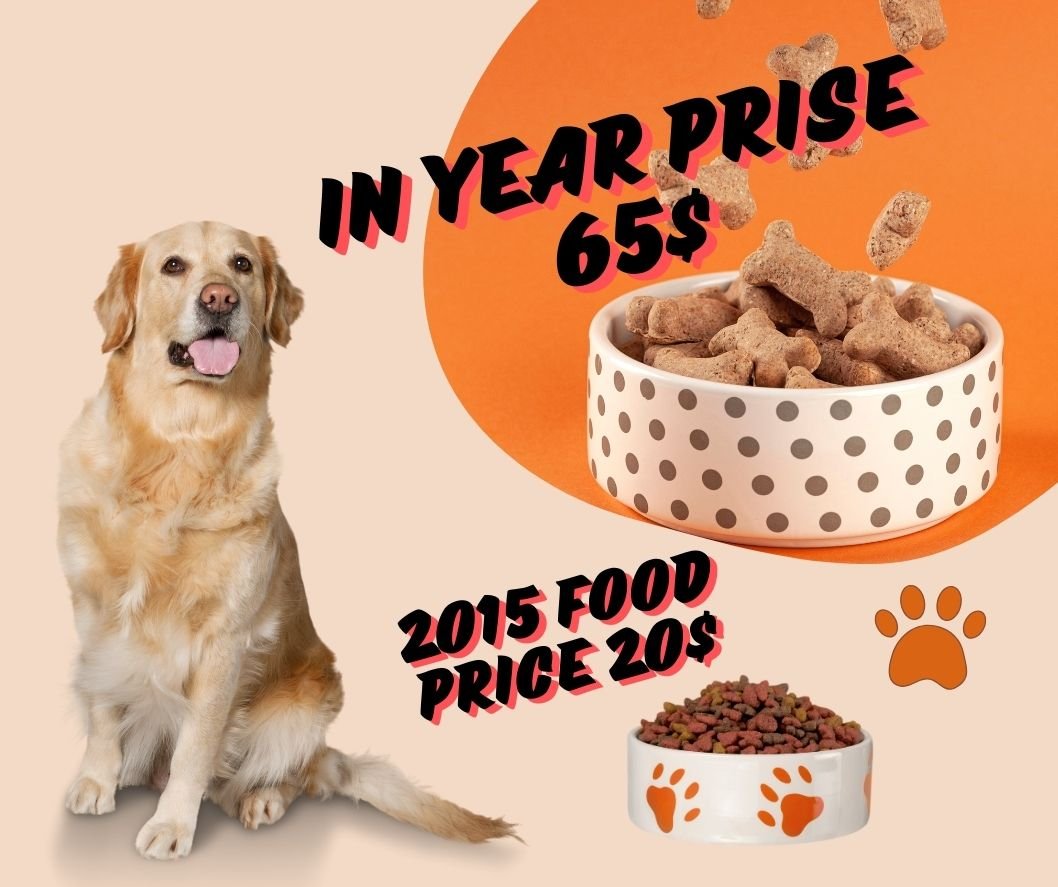Why is dog food so expensive it is discussed below Dog food is expensive due to high-quality ingredients and production costs. The increasing demand for premium pet food has also driven up prices.
As more pet owners seek healthier and nutritionally balanced options for their furry companions, the industry has responded with innovative formulations and improved manufacturing processes, all of which contribute to the higher costs. In addition, marketing and packaging also add to the overall expenses, making dog food a premium-priced item.
Despite the cost, many pet owners are willing to invest in their dogs’ well-being, driving the high-value pet food market. Overall, the expense of dog food is a result of various factors, including quality ingredients, production processes, and the growing demand for premium pet nutrition.

Credit: www.reddit.com
For more details: Click here
The Cost Factors
Ingredients Sourcing And Quality
Dog food is expensive due to the high costs associated with sourcing premium-quality ingredients. Manufacturers often prioritize locally sourced ingredients to ensure the freshest and most nutritious components for their products. This emphasis on quality increases the overall cost of production.
Production And Packaging Costs
Another major factor contributing to the expense of dog food is the production and packaging costs. From the processing of raw materials to the packaging of the final product, each step demands strict quality control and adherence to safety standards. This not only increases the production costs but also adds to the environmentally friendly packaging expenses.
Regulations & Standards
Discover why dog food prices are high due to stringent regulations and quality standards. The emphasis on premium ingredients and manufacturing processes contributes to the elevated costs. These regulations ensure the safety and health of pets, ultimately reflecting the price point.
Compliance Requirements
Dog food might seem expensive, but there are various reasons behind this. One of the key factors contributing to the high prices is the stringent regulations and standards that dog food manufacturers must adhere to. These regulations ensure the safety of the food and the well-being of our furry friends.
When it comes to dog food production, compliance requirements are in place to ensure that manufacturers follow strict guidelines in terms of ingredient sourcing, production processes, labeling, and storage. These regulations are designed to guarantee that the food meets certain quality and safety standards before reaching the shelves.
One of the compliance requirements that manufacturers must follow is ingredient sourcing. They need to use high-quality ingredients that are safe for dogs to consume. Additionally, these ingredients must adhere to specific specifications outlined by regulatory bodies. For example, meat used in dog food production should come from healthy animals fit for human consumption. This means that manufacturers may have to pay a premium for quality ingredients, ultimately leading to higher product costs.
Quality Control Measures
To ensure the safety and quality of dog food, manufacturers implement rigorous quality control measures. These measures involve tests, inspections, and monitoring at various stages of the production process. By implementing these measures, manufacturers aim to minimize the risk of contamination, mislabeling, and other safety issues.
Quality control measures typically include regular testing of raw materials to check for any possible contaminants or allergens. This ensures that the final product is free from any potential health hazards. Manufacturers also conduct routine inspections of their facilities to ensure sanitary conditions and adherence to food safety regulations.
Moreover, quality control measures cover product testing after the manufacturing process is complete. This testing includes nutritional analysis to ensure that the dog food meets the appropriate nutrient standards as specified by regulatory bodies. This attention to detail comes at a cost, as manufacturers need to invest in quality testing equipment and personnel. These additional expenses are reflected in the final price of the dog food.
In conclusion, dog food prices may appear high, but they are a result of the strict regulations and standards that manufacturers must follow. Compliance requirements ensure that the food is safe and of high quality. Quality control measures further guarantee that the dog food meets nutritional standards and is free from contaminants. As a pet owner, you can have peace of mind knowing that the extra cost you pay for dog food goes towards maintaining the health and well-being of your beloved furry companion.
Market Demand
Market demand is a key factor contributing to the current high pricing of dog food. With an increasing number of households owning pets, there is a growing demand for high-quality pet food products. This increased market demand has resulted in a shift towards premium formulas and specialized products, ultimately impacting the cost of dog food.
Trends In Pet Ownership
The trend of pet ownership has seen a significant upsurge in recent years, with more individuals welcoming furry companions into their homes. This rise in pet ownership has created a notable surge in demand for pet-related products, including high-quality dog food. As households continue to embrace pets as valued members of the family, the need for nutritious and premium pet food options has soared.
Premium Products In Demand
Increasingly, pet owners are seeking out premium and specialized dog food products to ensure the well-being and longevity of their furry friends. This demand for top-tier formulas has led to the development and availability of a wide range of premium dog food options in the market. As a result, the competition in this niche has intensified, influencing the overall pricing of dog food and leading to higher expenses for pet owners.
Distribution & Retail Markup
Distribution and retail markup are key factors contributing to the high cost of dog food. Supply chain logistics, including transportation and warehousing, involve several steps that add to the overall expenses. Retail profit margins are also a significant factor, with retailers marking up the price of dog food to cover their costs and generate profit.
Supply Chain Logistics
Supply chain logistics for dog food involves a complex process that includes sourcing ingredients, manufacturing, packaging, and distributing the final product. Each step requires careful coordination and incurs costs that ultimately get passed on to consumers.
Here is a breakdown of the supply chain logistics:
- Sourcing Ingredients: Dog food manufacturers need to procure high-quality ingredients, which often come at a premium price due to factors such as organic certification or specialized dietary requirements.
- Manufacturing: The manufacturing process itself involves the use of specialized equipment and facilities, along with the labor cost of skilled workers to ensure the quality and safety of the dog food.
- Packaging: Proper packaging is essential to maintain the freshness and shelf-life of dog food. This includes the cost of materials and equipment required for packaging, as well as labeling and regulatory compliance.
- Distribution: Once the dog food is manufactured and packaged, it needs to be transported to various distribution centers and retail stores. This involves expenses such as transportation costs, fuel, and storage fees.
Retail Profit Margins
Retailers play a crucial role in bringing dog food to consumers. They not only provide a physical store to buy dog food but also offer convenience and expertise in choosing the right product. However, retailers need to cover their operational costs and make a profit, which leads to a markup on the price of dog food they sell.
Here are some factors that contribute to retail profit margins:
- Operational Costs: Running a retail store involves expenses such as rent, utilities, employee wages, and marketing. These costs need to be covered to ensure the smooth operation of the business.
- Inventory Management: Retailers need to invest in maintaining an inventory of different dog food brands and variants. This includes costs associated with ordering, stocking, and managing inventory levels.
- Customer Service: Providing knowledgeable staff who can assist customers in selecting the right dog food requires training and ongoing investment in employee development.
- Profit Generation: Retailers need to generate a certain level of profit to sustain their business and remain competitive in the market. This is achieved through the markup applied to the original cost of dog food.
All these factors contribute to the higher price of dog food in retail stores, making it more expensive compared to other sources or homemade alternatives.
Advertising & Branding
Dog food prices can be puzzling, but much of it is attributed to Advertising & Branding strategies. Let’s dive into the Marketing expenses and Brand positioning strategies that contribute to the high costs.
Marketing Expenses
In the world of dog food, Marketing expenses play a crucial role in the final price tag. Companies invest heavily in advertising campaigns, which include TV commercials, print ads, social media promotions, and sponsorships.
Brand Positioning Strategies
Brand positioning strategies are the key to attracting loyal customers. By creating a unique brand image and emphasizing quality ingredients, dog food companies can charge premium prices for their products.
Health Benefits & Research
Dog food prices might be high due to the extensive health benefits and research that go into creating nutritious meals for your furry companions.
Nutritional Research Costs
In-depth studies on pet nutrition can drive up the production expenses of dog food.
Health Claims Support
Ensuring that health claims are backed by scientific evidence can increase the cost of formulating dog food.
Competition & Pricing Strategy
Dog food is often perceived as expensive, and one of the reasons behind this issue is the competitive landscape within the pet food industry. Various companies strategize to stand out in the market, resulting in the implementation of different pricing tactics to gain a competitive edge. Let’s dig deeper into the competitive landscape and price differentiation tactics.
Competitive Landscape
The pet food market is saturated with numerous brands vying for consumer attention. This intense competition has led to a diverse range of products and prices, reflecting varying quality. Well-established names in the industry with a loyal customer base often command higher prices, while new entrants may offer lower-priced alternatives to gain a foothold in the market.
Price Differentiation Tactics
Companies employ various strategies to differentiate their products in terms of price. Some focus on premium ingredients and market their products as a high-end, nutritious option, thereby justifying a higher price point. On the other hand, some brands opt for competitive pricing, aiming to capture a broader customer base. Additionally, promotional tactics such as discounts, bundle offers, and loyalty programs play a role in pricing strategies.

Credit: rawdogfoodandco.com
Consumer Perception
Understanding consumer perception helps explain why dog food is expensive. Quality ingredients and nutritional value impact pricing, influencing how consumers view dog food. Premium brands often position themselves as offering superior products, shaping consumer willingness to pay higher prices.
One of the key factors that contribute to the high cost of dog food is consumer perception. This refers to the way pet owners view and interpret the value of dog food about its actual cost.
Perceived Value Vs. Actual Cost
Pet owners often have a perceived value of dog food that is higher than its actual cost. This perception can be influenced by a variety of factors such as branding, marketing, and the belief that expensive dog food equates to better quality and nutrition for their beloved pets.
This emotional attachment to pets plays a significant role in shaping consumer perception. Pet owners want the best for their furry companions and are willing to spend more on premium dog food to provide them with a healthy and balanced diet.
However, it’s important to note that the actual cost of manufacturing dog food is influenced by a range of factors, including ingredients, production processes, packaging, and marketing expenses.
In many cases, premium dog food brands invest heavily in research and development to ensure that their products meet strict quality standards. This commitment to delivering high-quality dog food comes with a higher cost, which is reflected in the price consumers pay at the point of purchase.
Moreover, the rising demand for natural, organic, and grain-free dog food options has also contributed to the increase in prices. These specialized diets often require more expensive ingredients and meticulous production processes, resulting in higher manufacturing costs.
Additionally, factors such as packaging, marketing campaigns, and distribution expenses also contribute to the overall cost of dog food. Premium brands often invest in eye-catching packaging and extensive marketing efforts to attract consumers and create a sense of value and exclusivity.
Summary:
- Consumer perception plays a crucial role in the high cost of dog food.
- Pet owners have a perceived value of dog food that is often higher than its actual cost.
- Emotional attachment to pets and the desire to provide the best for them drives this perception.
- The actual cost of manufacturing dog food is influenced by various factors including ingredients, production processes, packaging, and marketing expenses.
- Rising demand for specialized diets and the use of quality ingredients contribute to the higher costs.
- Marketing, packaging, and distribution expenses also add to the overall price of dog food.
Why is Dog Food So Expensive? Click here to learn more about this
/cdn.vox-cdn.com/uploads/chorus_image/image/70860268/GettyImages_1153468010.0.jpg)
Credit: www.vox.com
Frequently Asked Questions:
Why is Dog Food So Expensive?
The price of this product has increased mainly due to the higher price of the product in the current era compared to the previous full.
Why Is Dog Food Suddenly So Expensive?
Due to increased demand and supply chain disruptions, dog food prices have risen abruptly.
Why Is Dog Food So Expensive In a Year?
Dog food in 2024 is expensive due to rising ingredient costs, increased demand, and transportation expenses. Supply chain disruptions also impact pricing.
Is It OK to Feed Your Dog Cheap Dog Food?
Feeding your dog cheap dog food is not recommended. Good nutrition is crucial for their health and well-being. Quality dog food ensures they receive essential nutrients and avoids potential health issues. Prioritize their health by investing in proper nutrition for your furry friend.
Is Buying Expensive Dog Food Worth It?
Yes, buying expensive dog food is worth it as it provides high-quality ingredients for your pet’s health and well-being. It helps maintain a healthy coat, supports immunity, and promotes better digestion, resulting in fewer vet visits.
What is the best dog food at a low price in this day and age?
Details about it are given on this page.
Conclusion
Understanding the factors driving up dog food prices can provide valuable insights for pet owners. By recognizing the impact of ingredient quality, production costs, and industry trends, consumers can make informed decisions about their pet’s nutrition. While the expense may seem daunting, prioritizing the well-being of our furry companions is always worth the investment.

Hello I am Farhana I have been doing research on dogs since last 10 years. I have been doing research on dog special parts or dog food since last 10 years. I have gained knowledge about my dog in these ten years so. I want to blog about it daily.

